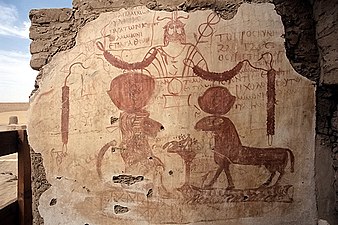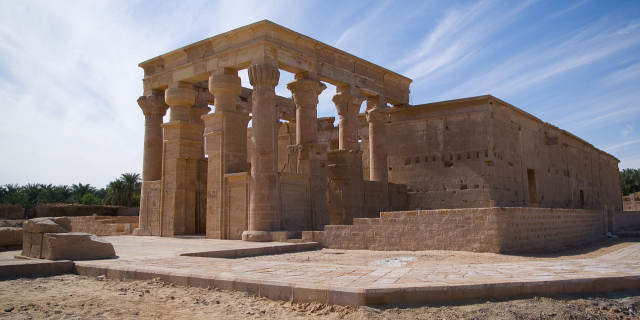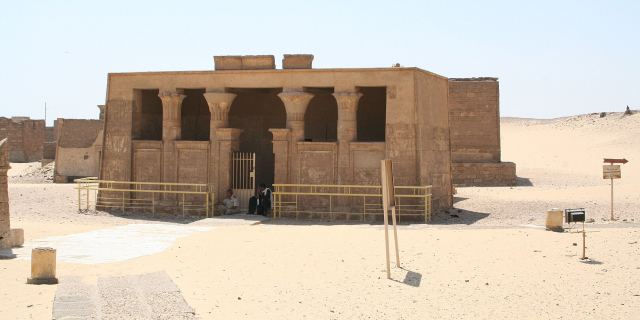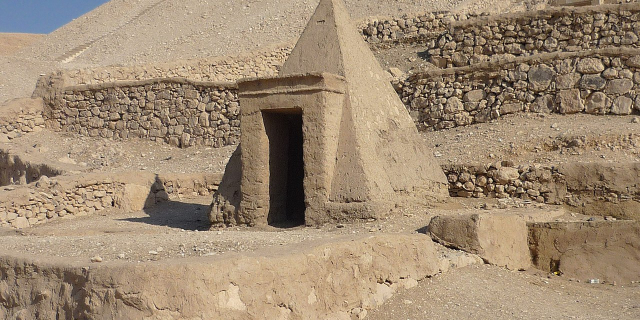الواحات الداخلة
( Dakhla Oasis )
Dakhla Oasis or Dakhleh Oasis (Egyptian Arabic: الداخلة El Daḵla, pronounced [edˈdæxlæ], "the inner oasis"), is one of the seven oases of Egypt's Western Desert. Dakhla Oasis lies in the New Valley Governorate, 350 km (220 mi.) from the Nile and between the oases of Farafra and Kharga. It measures approximately 80 km (50 mi) from east to west and 25 km (16 mi) from north to south.
The first contacts between the pharaonic power and the oases started around 2550 BCE. The human history of this oasis started during the Pleistocene, when nomadic tribes settled sometimes there, in a time when the Sahara climate was wetter and where humans could have access to lakes and marshes. But about 6,000 years ago, the entire Sahara became drier, changing progressively into a hyper-arid desert (with less than 50 mm of rain per year). However, specialists think that nomadic hunter-gatherers began to settle almost permanently in the oasis of Dakhleh in the period of the Holocene (about 12,000 years ago), during new, but rare episodes of wetter times.
In fact, the drier climate didn't mean that there was more water than today in what is now known as the Western Desert. The south of the Libyan Desert has the most important supply of subterranean water in the world through the Nubian Aquifer, and the first inhabitants of the Dakhla Oasis had access to surface water sources. In the third millennium BC the probably nomadic people of the Sheikh Muftah culture lived here.
Pharaonic periodDuring the late 6th Dynasty, hieratic script was sometimes incised into clay tablets with a stylus, similar to cuneiform. About five hundred such tablets have been discovered in the governor's palace at Ayn Asil (Balat) in the Dakhla Oasis.[1][2] At the time the tablets were made, Dakhla was located far from centers of papyrus production.[3] These tablets record inventories, name-lists, accounts, and approximately fifty letters.
Deir el-HagarDeir el-Hagar, (Egyptian Arabic: دير الحجر 'Monastery of Stone', Ancient Egyptian: S.t-wȝḥ, Sioua[4]), is a Roman sandstone temple on the western edge of Dakhla Oasis, about 10 km from Qasr ad-Dakhla. The Temple was erected during the reign of the Roman Emperor Nero, and decorated during the time of Vespasian, Titus and Domitian. The temple was dedicated to the Theban triad, composed of Amun-Ra, Mut and Khonsu, as well as to Seth, the main deity of the region.[5]



The fortified Islamic town of Qasr ad-Dakhla or el-Qasr (Arabic: قصر الداخلة, the Fortress) was built in the 12th century on the remains of a Roman fort in the NW of the Dakhla Oasis by the Ayyubid kings. Many of the up to four-storey mud brick Ottoman and Mamluk buildings contain blocks of stone with hieroglyphics from the ancient Thoth temple of the nearby site of Amheida. The three-storey, 21-meter-high minaret is dated 924 CE.[6]







Sir Archibald Edmonstone visited Dakhla oasis in the year 1819.[7] He was succeeded by several other early travellers, among whom Friedrich Gerhard Rohlfs in 1873-1874. It was not until 1908 that the first Egyptologist, Herbert Winlock, visited Dakhla Oasis and noted its monuments in some systematic manner.[7] In the 1950s, detailed studies began, first by Ahmed Fakhry, and in the late 1970s, expeditions of the Institut Français d'Archéologie Orientale and the Dakhleh Oasis Project (see below) each began detailed studies in the oasis.[7]
Recent discoveriesIn August 2017, archaeologists from the Ministry of Antiquities announced the discovery of five mud-brick tombs at Bir esh-Shaghala, dating back nearly 2000 years. Researchers also revealed worn masks gilded with gold, several large jars and a piece of pottery with unsolved ancient Egyptian writing on it.[8][9]
Some of the tombs are completely large containing several burial chambers, while one tomb has a roof built in the shape of a pyramid and some of them with vaulted roofs.[10]




























Add new comment